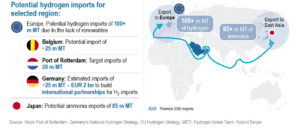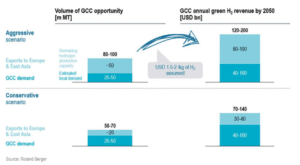Hydrogen in the GCC: The new Oil Economy?

Table of Contents
The world is currently shifting its energy system away from hydrocarbons and towards low-carbon energy sources, with a view to eventually transitioning to a net-zero energy system. As a result, governments and energy companies alike are placing large wagers on hydrogen, in an effort to lower emissions.
The GCC countries have long been concerned about the sustainability of their hydrocarbon revenues and have taken early steps to develop national hydrogen strategies. Saudi Arabia and the United Arab Emirates lead the way in this regard and have positioned themselves to become major hydrogen exporters.
Japan, China, and South Korea, on the other hand, currently some of the top destinations for Saudi and Emirati crude oil, are set to emerge as major importers of hydrogen. The recent export by the Emirates’ state-owned oil company ADNOC, of its first blue hydrogen cargo to Japan, marks the first step toward solidifying this emerging relationship.
Hydrogen Steadily Gaining Ground in the GCC
The UAE joined the Global Hydrogen Council in July 2021, and developed its National Clean Energy Strategy 2050, under which ADNOC will produce 300,000 metric tonnes of hydrogen annually. In Saudi Arabia, a green hydrogen project is scheduled for completion by 2025, with a capacity of 650 metric tonnes of hydrogen, and 1.2 million tonnes of green ammonia, making it one of the largest such projects in the world.
In Kuwait, meanwhile, the National Petroleum Company (KNPC) has completed work on a hydrocracker unit at a cost of $16 billion, that can produce 454,000 tonnes of clean fuel. Oman Oil Company, for its part, is implementing a project to produce 1.8 million tonnes of green hydrogen at a cost of $30 billion, using solar and wind energy.
Factors favoring the production of Blue Hydrogen* in the GCC
(*Hydrogen produced using carbon capture and storage technology to store the CO2 created as a byproduct of the process)
- The GCC is one of the largest and lowest-cost producers of natural gas globally, accounting for 20% of the world’s gas reserves. Qatar is the third-largest worldwide, with 24.7 trillion cubic meters (TCM) of proven natural gas reserves, while Saudi Arabia (6 TCM) and the UAE (5.9 TCM) hold the ninth and tenth spots, respectively.
- The availability of existing facilities in the GCC involved in the production of ammonia, fertilizers, methanol, steel, and hydrogen. These facilities are often already concentrated in clusters along with power and desalination plants, making ideal centers to expand the use of the carbon capture, use, and storage (CCUS) needed to create blue hydrogen. Examples include the facilities of SABIC in Saudi Arabia, FERTIL in the UAE, QAFCO in Qatar, PIC16 in Kuwait, OMIFCO in Oman, and Bahrain’s SULB.
- GCC hydrocarbon producers have significant CO2 storage capacity. Carbon capture, utilization, and storage (CCUS) enable the production of low-carbon hydrogen, and the voided spaces in oil and gas fields alone, within the GCC, accounting for a storage capacity of 33.4 GtCO2e, allowing for ample reservoirs for hydrogen producers.
- GCC producers have well-developed existing infrastructure, such as their natural gas grids, which could be modified for transporting hydrogen inland for domestic purposes.
Factors favoring the production of Green Hydrogen* in the GCC:
(*Hydrogen produced using electricity generated from renewables, such as wind or solar)
- The GCC is a high-potential region for renewables benefitting from some of the highest solar radiation levels in the world, as well as strong and regular winds in some areas. This makes the GCC region potentially one of the most cost-competitive for hydrogen production, with long-term costs potentially reaching USD 1.5 – 2 per kg, compared to USD 3.0 – 4+ per kg in Europe and parts of Asia.
- GCC countries enjoy sufficient funding availability for investment in hydrogen, having created significant financial reserves from their oil & gas economies. These reserves allow them to cover the cost of producing green hydrogen, which is high compared to that of producing blue hydrogen.
- The GCC already has a highly qualified workforce in the oil & gas sector. This represents a major opportunity for the development of the hydrogen economy in the region, due to the high transferability of their skills.
- GCC countries have advanced export infrastructure. The UAE’s Jebel Ali and Saudi Arabia’s Jeddah ports, for instance, were among the top 40 ports in the world in 2019, according to the World Shipping Council.
- GCC countries are centrally located relative to energy demand markets, situated as they are between the potentially large European and East Asian markets.
Potential Hydrogen Imports from High Demand Regions
EU hydrogen imports from the GCC could reach 100 mMT by 2050, according to a recent report published by Dii & Roland Berger. In East Asia, meanwhile, imports from the GCC could reach approximately 85 mMT of ammonia by the same year, leaving GCC countries in a prime position to become major players in the hydrogen industry.
Source: Vision Port of Rotterdam, Germany’s National Hydrogen Strategy, EU Hydrogen Strategy, METI, Hydrogen Korea Team, Roland Berger, Dii Desert Energy.

Potential Revenues from Hydrogen Exports
Global hydrogen demand is expected to reach approximately 580 mMT by 2050. All indicators point to the potential for the GCC to replace its position as a global oil giant, with that of a global hydrogen hub, with potential green hydrogen revenues alone expected to reach USD 70-200 billion by 2050.

Looking Forward
The GCC is in an excellent position to become a leading green and blue hydrogen producer, which would allow the region to occupy an important place in the nascent hydrogen industry. By seizing this opportunity, GCC countries can ensure their continued prominence in the global energy market, all the while moving towards a decarbonized world. This shift is emblematic of the rising non-oil economy in oil countries, symbolizing a strategic pivot towards sustainable and diversified energy sources that promise economic resilience and environmental responsibility for future generations.
Author: Dina Amer
References:
MEI@75, Warming to a Multi-Colored Hydrogen Future? The GCC and Asia Pacific, 2021
https://www.mei.edu/publications/warming-multi-colored-hydrogen-future-gcc-and-asia-pacific
Gulf News, Gulf economies are ready to take on clean energy and hydrogen projects, 2021
Qamar Energy, Hydrogen in the GCC, a report for the regional business development team Gulf Region, 2020
https://www.rvo.nl/sites/default/files/2020/12/Hydrogen%20in%20the%20GCC.pdf
Dii Desert Energy & Roland Berger, The Potential for Green Hydrogen in the GCC region, 2021
Brookings, Economic diversification in the Gulf: Time to redouble efforts, 2021
https://www.brookings.edu/research/economic-diversification-in-the-gulf-time-to-redouble-efforts/
The IEA, The Future of Hydrogen; Seizing today’s opportunities, 2019
https://www.iea.org/reports/the-future-of-hydrogen
The IEA, The Role of CO2 Storage, 2019
https://www.iea.org/reports/the-role-of-co2-storage
KAPSARC, Opportunities for Natural Gas Trade and Infrastructure in the GCC, 2020